Tillandsia mauryana
Tillandsia mauryana was another one of those plants that made it on to my wish list pretty much the moment I saw it. Unfortunately though, it is another plant that is listed on appendix II of the “Convention on International Trade in Endangered Species of Wild Fauna and Flora”, or CITES as it is more commonly referred to. I wrote briefly of what this means and how it impacts a buyer in my earlier post on T. xerographica. T. mauryana is a small plant, growing to probably no more than 3″ tall at maturity, with short needle like leaves. Its natural habitat is central Mexico, where it grows on rocks in dry forests. Like many tills, it has a silver-grey colouring owing to the layer of trichomes on their leaves. New leaves grow upright, which generally spread horizontal and eventually the older ones start to curve downwards and you end up with a mature plant where the base does not actually touch the ground, and I can imagine that if a strong gust of wind were to occur, that it would behave almost like a miniature tumbleweed.
Well, I managed to get my hands on two of these guys back in May 2012, and surprise surprise but they were both in bloom. One of the plants could almost be considered a small clump, as it had a number of very small pups at the base of the plant – this almost clump shall from hereon out be referred to as plant 1, and it is the plant on the left in the pic below. Unfortunately though, most of the tiny little pups on plant 1had already dried out while in transit. The other plant I received was errmmm… exactly that, a nice single plant in bloom, and shall from hereon out be referred to as plant 2, and yes you guessed it, it is the plant on the right in the pic below.
It was interesting to see that although both plants came from the same source and were presumably grown in the same conditions, that plant 1 had a more silvery / furry appearance whilst plant 2 was slightly greener, which indicates a slightly thinner layering of trichomes perhaps (?). Anyway after snapping a few photos, I gave both plants a quick dip of maybe 10 minutes in order to rehydrate them a little.
About a week and a half after getting the plants, plant 1bloomed, however plant 2 decided it did not like the new environment and well, it just remained as it was. The floral bracts were a very sweet pastel pinkish-orange, whilst the flowers were a very unique lime green in colour, something I have not seen previously in my other tills. Of course I had a go at pollinating but given that plant 2 refused to bloom, I was not really expecting any success with just self-pollination.
Plant 1
Plant 2
After plant 1 bloomed, both plants essentially went into dormancy! I was keeping a close watch for pups on both, but alas I had no luck. Eventually both blooms started to dry up and even more annoyingly, plant 2 never did bloom.
It was not until a good six months later that the pups started to appear. I subsequently realised that they only started pupping after I had gotten so frustrated with the lack of growth and had virtually given up on the plants that I moved them. After all it was obvious that they were not particularly happy in the location I had placed them in initially, therefore I decided to stop pampering them so much and moved them to a less sheltered area. They then got caught in some of the tropical thunderstorms that constantly occurs here and finally, pups appeared! Well actually just the one pup in plant 1 (first picture below) and at least two pups in plant 2 (second picture below) that I could discern anyway at that early stage.
Well it just goes to show what a difference the correct growing environment can have on the plants and also demonstrates the hardiness of tills in general. Of course I now realise that it was lack of water that was the issue with these plants, so I should be thankful that they did not just up and die on me. When I first received the plants I scoured the internet but found little information about T. mauryana’s growing conditions, although what I did find out about its natural habitat indicated a preference for drier conditions. This also coincided with the general assumption that the majority of silver-grey type tills prefer drier growing conditions. Obviously in this case I overcompensated and did not provide enough water! Well live and learn I guess.
I now have both of these plants in the open, which means they get the full force of any storms and, depending on the time of the year, also a good deal of direct sunlight, as much as 6 to 7 hours of strong direct afternoon / evening sunlight. At other times of the year it is probably more like 3 to 4 hours of semi-shaded afternoon sunlight mixed with bright shade for the rest of the day. Keep in mind though that these particular plants were well acclimatised to the local weather and therefore did not have any issue with the transition. I am pretty sure they would not have been so tolerant of this sunny tropical weather if I had chucked them out immediately when I received them. Another matter I should point out is that I have both plants suspended upside down by fishing line in order to prevent water collecting at the centre, because I still have this sneaking suspicion that mauryanas would be rather prone to rot from excess water, and given the weather here has been rather erratic, it is probably better to be safe than sorry.
Now that I have figured out what makes them happy, they seem surprisingly low maintenance. Nothing more than regular tillandsia care seems to be all that is needed, although with the conditions I have them in, I find that they do prefer a higher amount of watering. With the current wet weather we have been experiencing though, what this essentially means is I leave them be and check in every couple of weeks. Anyway a good 11 months after I got them, the pup in plant 1 is now a decent (albeit still rather small) size and the growth rate seems to be slow to average for tills. Plant 2 which did not bloom in the end has actually given out 3 pups, but they are still very small and relatively slow growing in comparison to its counterpart.
To end with I have put some more recent pictures below for your viewing pleasure. Thanks for reading and happy growing everyone!

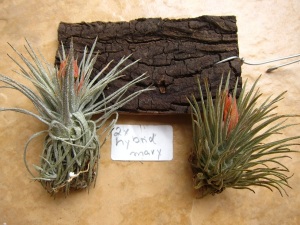





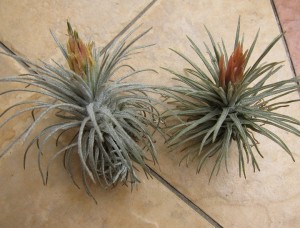
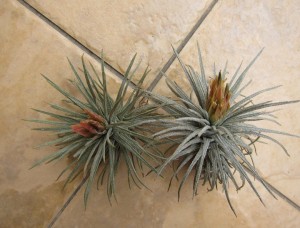

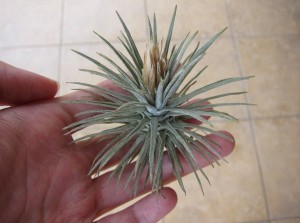

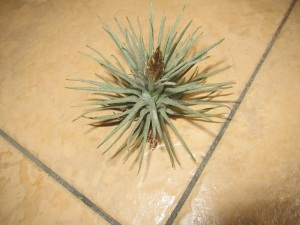

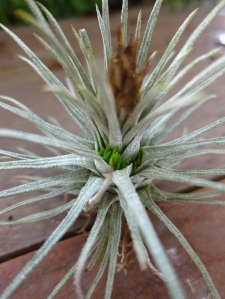

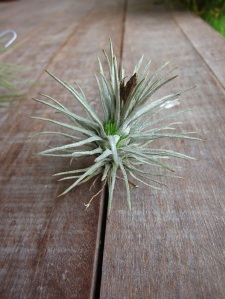
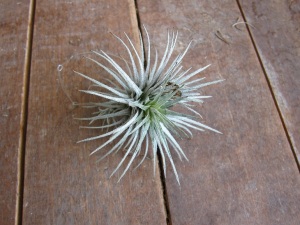

Hi, I recently got “poisoned” by tillies, and I am keen to know more about them. May I know where you get your Tillandsia mauryana? I am fascinated by their “snow” colour on the leaves. Thanks!
Anyway, nice blog you have there!
Thank you, so much for your very informative post!!
I am new to Tillandsias , i just ordered 1 Maruyana,
I live in Hawaii on the island of Maui, area that I live in has tradewinds blowing most of time, sunny w/ occ showers
temp mid 70’s-high 80’s ,
i have a hot house covered w/ shade cloth.
Any tips/suggestions would be greatly appreciated!
Aloha
Cindy